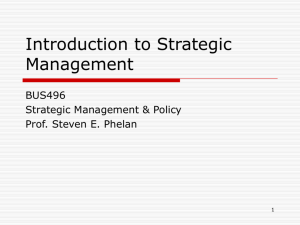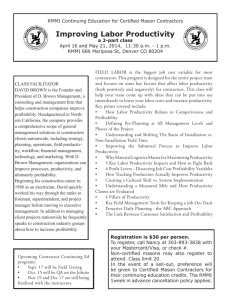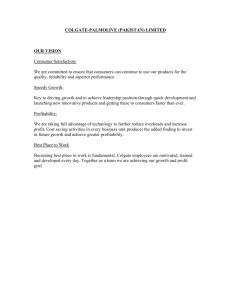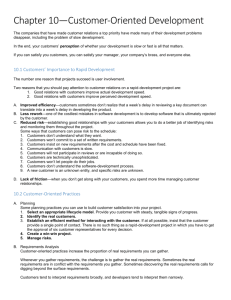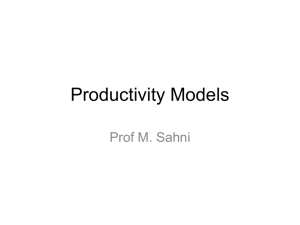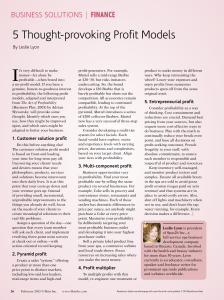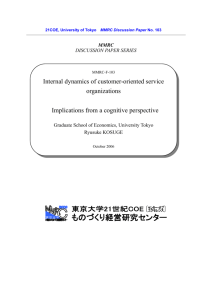Mission Statement The first component of the strategic management
advertisement
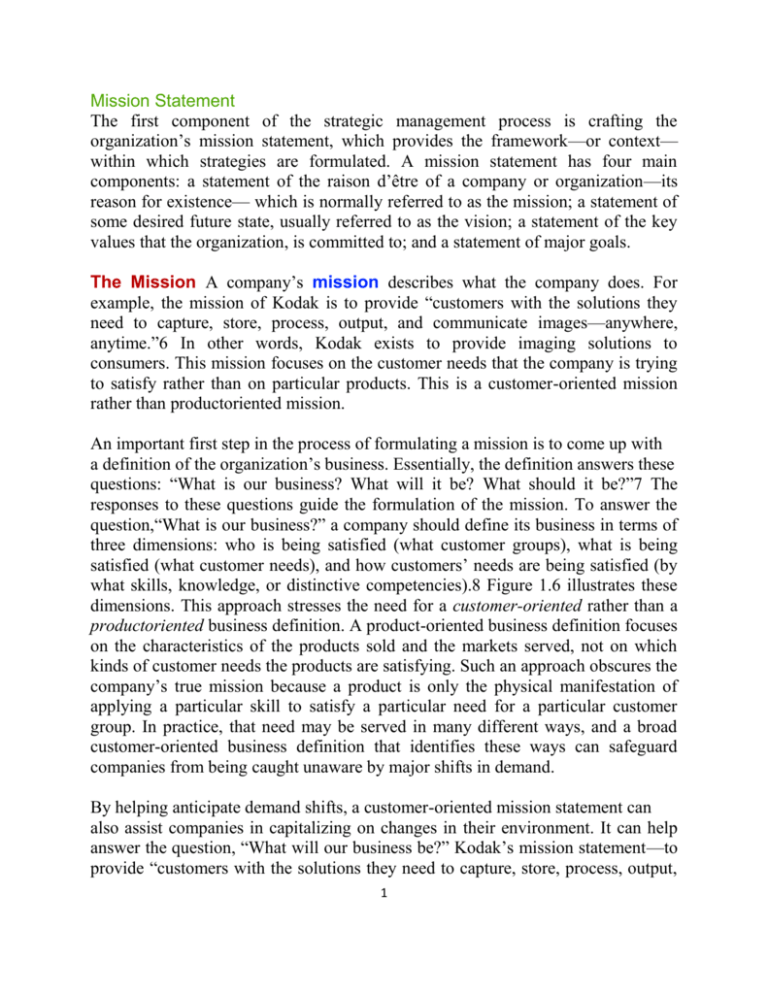
Mission Statement The first component of the strategic management process is crafting the organization’s mission statement, which provides the framework—or context— within which strategies are formulated. A mission statement has four main components: a statement of the raison d’être of a company or organization—its reason for existence— which is normally referred to as the mission; a statement of some desired future state, usually referred to as the vision; a statement of the key values that the organization, is committed to; and a statement of major goals. The Mission A company’s mission describes what the company does. For example, the mission of Kodak is to provide “customers with the solutions they need to capture, store, process, output, and communicate images—anywhere, anytime.”6 In other words, Kodak exists to provide imaging solutions to consumers. This mission focuses on the customer needs that the company is trying to satisfy rather than on particular products. This is a customer-oriented mission rather than productoriented mission. An important first step in the process of formulating a mission is to come up with a definition of the organization’s business. Essentially, the definition answers these questions: “What is our business? What will it be? What should it be?”7 The responses to these questions guide the formulation of the mission. To answer the question,“What is our business?” a company should define its business in terms of three dimensions: who is being satisfied (what customer groups), what is being satisfied (what customer needs), and how customers’ needs are being satisfied (by what skills, knowledge, or distinctive competencies).8 Figure 1.6 illustrates these dimensions. This approach stresses the need for a customer-oriented rather than a productoriented business definition. A product-oriented business definition focuses on the characteristics of the products sold and the markets served, not on which kinds of customer needs the products are satisfying. Such an approach obscures the company’s true mission because a product is only the physical manifestation of applying a particular skill to satisfy a particular need for a particular customer group. In practice, that need may be served in many different ways, and a broad customer-oriented business definition that identifies these ways can safeguard companies from being caught unaware by major shifts in demand. By helping anticipate demand shifts, a customer-oriented mission statement can also assist companies in capitalizing on changes in their environment. It can help answer the question, “What will our business be?” Kodak’s mission statement—to provide “customers with the solutions they need to capture, store, process, output, 1 and communicate images”—is a customer-oriented statement that focuses on customer needs rather than a particular product (or solution) for satisfying those needs, such as chemical film processing. For this reason, from the early-1990s onward the mission statement has driven Kodak’s choice to invest in digital imaging technologies, which replaced much of its traditional business based on chemical film processing. The need to take a customer-oriented view of a company’s business has often been ignored. Business history is peppered with the ghosts of once-great corporations that did not define their business, or defined it incorrectly, so that ultimately they declined. In the 1950s and 1960s, many office equipment companies, such as Smith Corona and Underwood, defined their businesses as being the production of typewriters. This product-oriented definition ignored the fact that they were really in the business of satisfying customers’ informationprocessing needs. Unfortunately for those companies, when a new form of technology appeared that better served customer needs for information processing (computers), demand for typewriters plummeted. The last great typewriter company, Smith Corona, went bankrupt in 1996, a victim of the success of computer-based word-processing technology. In contrast, IBM correctly foresaw what its business would be. In the 1950s, IBM was a leader in the manufacture of typewriters and mechanical tabulating equipment using punch-card technology. However, unlike many of its competitors, IBM defined its business as providing a means for information processing and storage, rather thanonly supplying mechanical tabulating equipment and typewriters.9 Given this definition, the company’s subsequent moves into computers, software systems, office systems, and printers seem logical. Vision The vision of a company defines a desired future state; it articulates, often in bold terms, what the company would like to achieve. Nokia, the world’s largest manufacturer of mobile (wireless) phones, has been operating with a very simple but powerful vision for some time: “If it can go mobile, it will!” This vision implied that not only would voice telephony go mobile, but also a host of other services based on data, such as imaging and Internet browsing. This vision led Nokia to become a leader in developing mobile handsets that not only can be used for voice communication but that also take pictures, browse the Internet, play games, and manipulate personal and corporate information. 2 Values The values of a company state how managers and employees should conduct themselves, how they should do business, and what kind of organization they should build to help a company achieve its mission. Insofar as they help drive and shape behavior within a company, values are commonly seen as the bedrock of a company’s organizational culture: the set of values, norms, and standards that control how employees work to achieve an organization’s mission and goals. An organization’s culture is commonly seen as an important source of its competitive advantage.10 (We discuss the issue of organization culture in depth in Chapter 12.) For example, Nucor Steel is one of the most productive and profitable steel firms in the world. Its competitive advantage is based, in part, on the extremely high productivity of its work force, which the company maintains is a direct result of its cultural values, which in turn determine how it treats its employees. These values are as follows: • “Management is obligated to manage Nucor in such a way that employees will have the opportunity to earn according to their productivity.” • “Employees should be able to feel confident that if they do their jobs properly, they will have a job tomorrow.” • “Employees have the right to be treated fairly and must believe that they will be.” • “Employees must have an avenue of appeal when they believe they are being treated unfairly.”11 At Nucor, values emphasizing pay-for-performance, job security, and fair treatment for employees help to create an atmosphere within the company that leads to high employee productivity. In turn, this has helped to give Nucor one of the lowest cost structures in its industry, and helps to explain the company’s profitability in a very price-competitive business. In one study of organizational values, researchers identified a set of values associated with high-performing organizations that help companies achieve superior financial performance through their impact on employee behavior.12 These values included respect for the interests of key organizational stakeholders: individuals or groups that have an interest, claim, or stake in the company, in what it does, and in how well it performs.13 They include stockholders, bondholders, employees, customers, the communities in which the company does business, and the general public. The study found that deep respect for the interests of customers, employees, suppliers, and shareholders was associated with high performance. The study also noted that the encouragement of leadership and entrepreneurial behavior by mid- and lower-level managers and a willingness to support change efforts within the organization contributed to high performance. Companies that emphasize such values consistently throughout their organization include Hewlett3 Packard, Walmart, and PepsiCo. The same study identified the values of poorly performing companies—values that, as might be expected, are not articulated in company mission statements: (1) arrogance, particularly to ideas from outside the company; (2) a lack of respect for key stakeholders; and (3) a history of resisting change efforts and “punishing” mid- and lower-level managers who showed “too much leadership.” General Motors was held up as an example of one such organization. According to the research, a mid- or lower-level manager who showed too much leadership and initiative there was not promoted! Major Goals Having stated the mission, vision, and key values, strategic managers can take the next step in the formulation of a mission statement: establishing major goals. A goal is a precise and measurable desired future state that a company attempts to realize. In this context, the purpose of goals is to specify with precision what must be done if the company is to attain its mission or vision. Well-constructed goals have four main characteristics: • They are precise and measurable. Measurable goals give managers a yardstick or standard against which they can judge their performance. • They address crucial issues. To maintain focus, managers should select a limited number of major goals to assess the performance of the company. The goals that are selected should be crucial or important ones. • They are challenging but realistic. They give all employees an incentive to look for ways of improving the operations of an organization. If a goal is unrealistic in the challenges it poses, employees may give up; a goal that is too easy may fail to motivate managers and other employees. • They specify a time period in which the goals should be achieved, when that is appropriate. Time constraints tell employees that success requires a goal to be attained by a given date, not after that date. Deadlines can inject a sense of urgency into goal attainment and act as a motivator. However, not all goals require time constraints.Well-constructed goals also provide a means by which the performance of managers can be evaluated. As noted earlier, although most companies operate with a variety of goals, the primary goal of most corporations is to maximize shareholder returns, and doing this requires both high profitability and sustained profit growth. Thus, most companies operate with goals for profitability and profit growth. However, it is important that top managers do not make the mistake of overemphasizing current profitability to the detriment of long-term profitability and profit growth.16 The overzealous pursuit of current profitability to maximize short-term ROIC can encourage such misguided managerial actions as cutting expenditures judged to be nonessential in the short run—for instance, expenditures 4 for research and development, marketing, and new capital investments. Although cutting current expenditure increases current profitability, the resulting underinvestment, lack of innovation, and diminished marketing can jeopardize long-run profitability and profit growth. To guard against short-run decisionmaking, managers need to ensure that they adopt goals whose attainment will increase the long-run performance and competitiveness of their enterprise. Longterm goals are related to such issues as product development, customer satisfaction, and efficiency, and they emphasize specific objectives or targets concerning such details as employee and capital productivity, product quality, innovation, customer satisfaction, and customer service External Analysis The second component of the strategic management process is an analysis of the organization’s external operating environment. The essential purpose of the external analysis is to identify strategic opportunities and threats within the organization’s operating environment that will affect how it pursues its mission. Strategy in Action 1.1 describes how an analysis of opportunities and threats in the external environment led to a strategic shift at Time Inc. Three interrelated environments should be examined when undertaking an external analysis: the industry environment in which the company operates, the country or national environment, and the wider socioeconomic or macroenvironment. Analyzing the industry environment requires an assessment of the competitive structure of the company’s industry, including the competitive position of the company and its major rivals. It also requires analysis of the nature, stage, dynamics, and history of the industry. Because many markets are now global markets, analyzing the industry environment also means assessing the impact of globalization on competition within an industry. Such an analysis may reveal that a companyshould move some production facilities to another nation, that it should aggressively expand in emerging markets such as China, or that it should beware of new competition from emerging nations. Analyzing the macroenvironment consists of examining macroeconomic, social, government, legal, international,and technological factors that may affect the company and its industry. We look at external analysis in Chapter 2. Internal Analysis Internal analysis, the third component of the strategic planning process, focuses on reviewing the resources, capabilities, and competencies of a company. The goal is to identify the strengths and weaknesses of the company. For example, as 5 described in Strategy in Action 1.1, an internal analysis at Time Inc. revealed that while the company had strong well-known brands such as Fortune, Money, Sports Illustrated, and People (a strength), and strong reporting capabilities (another strength), it suffered from a lack of editorial commitment to online publishing (aweakness). We consider internal analysis in Chapter 3. SWOT Analysis and the Business Model The next component of strategic thinking requires the generation of a series of strategic alternatives, or choices of future strategies to pursue, given the company’s internal strengths and weaknesses and its external opportunities and threats. The comparison of strengths, weaknesses, opportunities, and threats is normally referred to as a SWOT analysis. The central purpose is to identify the strategies to exploit external opportunities, counter threats, build on and protect company strengths, and eradicate weaknesses. At Time Inc., managers saw the move of readership to the Web as both an opportunity that they must exploit and a threat to Time’s established print magazines. Managers recognized that Time’s well-known brands and strong reporting capabilities were strengths that would serve it well online, but that an editorial culture that marginalized online publishing was a weakness that had to be fixed. The strategies that managers at Time Inc. came up with included merging the print and online newsrooms to remove distinctions between them; investing significant financial resources in online sites; and entering into a partnership with CNN, which already had a strong online presence. More generally, the goal of a SWOT analysis is to create, affirm, or fine-tune a company-specific business model that will best align, fit, or match a company’s resources and capabilities to the demands of the environment in which it operates. Managers compare and contrast the various alternative possible strategies against each other and then identify the set of strategies that will create and sustain a competitive advantage. These strategies can be divided into four main categories: • Functional-level strategies, directed at improving the effectiveness of operations within a company, such as manufacturing, marketing, materials management, product development, and customer service. We review functional-level strategies in Chapter 4. • Business-level strategies, which encompasses the business’s overall competitive theme, the way it positions itself in the marketplace to gain a competitive advantage, and the different positioning strategies that can be used in 6 differentindustry settings—for example, cost leadership, differentiation, focusing on a particular niche or segment of the industry, or some combination of these. We review business- level strategies in Chapters 5, 6, and 7. • Global strategies, which addresses how to expand operations outside the home country to grow and prosper in a world where competitive advantage is determined at a global level. We review global strategies in Chapter 8. • Corporate-level strategies, which answer the primary questions: What business or businesses should we be in to maximize the long-run profitability and profit growth of the organization, and how should we enter and increase our presence in these businesses to gain a competitive advantage? We review corporate-level strategies in Chapters 9 and 10. The strategies identified through a SWOT analysis should be congruent with each other. Thus, functional-level strategies should be consistent with, or support, the company’s business-level strategy and global strategy. Moreover, as we explain later in this book, corporate-level strategies should support businesslevel strategies. When combined, the various strategies pursued by a company should constitute a complete, viable business model. In essence, a SWOT analysis is a methodology for choosing between competing business models, and for finetuning the business model that managers choose. For example, when Microsoft entered the videogame market with its Xbox offering, it had to settle on the best business model for competing in this market. Microsoft used a SWOT type of analysis to compare alternatives and settled on a “razor and razor blades” business model in which the Xbox console is priced below cost to build sales (the “razor”), while profits are made from royalties on the sale of games for the Xbox (the “blades”). 7 Strategy Implementation Once managers have chosen a set of congruent strategies to achieve a competitive advantage and increase performance, managers must put those strategies into action: strategy has to be implemented. Strategy implementation involves taking actions at the functional, business, and corporate levels to execute a strategic plan. Implementation can include, for example, putting quality improvement programs into place, changing the way a product is designed, positioning the product differently in the marketplace, segmenting the marketing and offering different versions of the product to different consumer groups, implementing price increases or decreases, expanding through mergers and acquisitions, or downsizing the company by closing down or selling off parts of the company. These and other topics are discussed in detail in Chapters 4 through 10. Strategy implementation also entails designing the best organization structure and the best culture and control systems to put a chosen strategy into action. In addition, senior managers need to put a governance system in place to make sure that all within the organization act in a manner that is not only consistent with maximizing profitability and profit growth, but also legal and ethical. In this book, we look at the topic of governance and ethics in Chapter 11; we discuss the organization structure, culture, and controls required to implement business-level strategies in Chapter 12; and discuss the structure, culture, and controls required to implement corporatelevelstrategies in Chapter 13. The Feedback Loop The feedback loop in Figure 1.5 indicates that strategic planning is ongoing: it never ends. Once a strategy has been implemented, its execution must be monitored to determine the extent to which strategic goals and objectives are actually beingachieved, and to what degree competitive advantage is being created and sustained. This information and knowledge is returned to the corporate level through feedback loops, and becomes the input for the next round of strategy formulation and implementation. Top managers can then decide whether to reaffirm the existing business model and the existing strategies and goals, or suggest changes for the future. For example, if a strategic goal proves too optimistic, the next time, a more conservative goal is set. Or, feedback may reveal that the business model is not working, so managers may seek ways to change it. In essence, this is what happened at Time Inc. (see Strategy in Action 1.1). Strategy as an Emergent Process The planning model suggests that a company’s strategies are the result of a plan, that the strategic planning process is rational and highly structured, and that top management orchestrates the process. Several scholars have criticized the formal 8 planning model for three main reasons: the unpredictability of the real world, the role that lower-level managers can play in the strategic management process, and the fact that many successful strategies are often the result of serendipity, not rational strategizing. These scholars have advocated an alternative view of strategy making.18 Strategy Making in an Unpredictable World Critics of formal planning systems argue that we live in a world in which uncertainty, complexity, and ambiguity dominate, and in which small chance events can have a large and unpredictable impact on outcomes.19 In such circumstances, they claim, even the most carefully thought-out strategic plans are prone to being rendered useless by rapid and unforeseen change. In an unpredictable world, being able to respond quickly to changing circumstances, and to alter the strategies of the organization accordingly, is paramount. The dramatic rise of Google, for example, with its business model-based revenues earned from advertising links associated with search results (the so-called pay-per-click business model), disrupted the business models of companies that made money from online advertising. Nobody could foresee this development or plan for it, but companies had to respond to it, and rapidly. Companies with a strong online advertising presence, including Yahoo.com and Microsoft’s MSN network, rapidly changed their strategies to adapt to the threat Google posed. Specifically, both companies developed their own search engines and copied Google’s pay-per-click business model. According to critics of formal systems, such a flexible approach to strategy-making is not possible within the framework of a traditional strategic planning process, with its implicit assumption that an organization’s strategies only need to be reviewed during the annua lAutonomous Action: Strategy Making by Lower-Level Managers Another criticism leveled at the rational planning model of strategy is that too much importance is attached to the role of top management, particularly the CEO.20 An alternative view is that individual managers deep within an organization can—and often do—exert a profound influence over the strategic direction of the firm.21 Writing with Robert Burgelman of Stanford University, Andy Grove, the former CEO of Intel, noted that many important strategic decisions at Intel were initiated not by top managers but by the autonomous action of lower-level managers deep within Intel who, on their own initiative, formulated new strategies and worked to persuade top-level managers to alter the strategic priorities of the firm.22 These strategic decisions included the decision to exit an important market (the DRAM memory chip market) and to develop a certain class of microprocessors (RISC-based microprocessors) in direct contrast to the stated strategy of Intel’s top managers. Another example of autonomous action, this one 9 at Starbucks, is given in Strategy in Action 1.2. Autonomous action may be particularly important in helping established companies deal with the uncertainty created by the arrival of a radical new technology that changes the dominant paradigm in an industry.23 Top managers usually rise to preeminence by successfully executing the established strategy of thefirm. Therefore, they may have an emotional commitment to the status quo and are often unable to see things from a different perspective. In this sense, they canbe a conservative force that promotes inertia. Lower-level managers, however, are less likely to have the same commitment to the status quo and have more to gain from promoting new technologies and strategies. They may be the first ones to recognize new strategic opportunities and lobby for strategic change. As described in Strategy in Action 1.3, this seems to have been the case at discount stockbroker, Charles Schwab, which had to adjust to the arrival of the Web inthe 1990s. Serendipity and Strategy Business history is replete with examples of accidental events that help to push companies in new and profitable directions. What these examples suggest is that many successful strategies are not the result of well-thought-out plans, but of serendipity— stumbling across good things unexpectedly. One such example occurred at 3M during the 1960s. At that time, 3M was producing fluorocarbons for sale as coolant liquid in air conditioning equipment. One day, a researcher working with fluorocarbons in a 3M lab spilled some of the liquid on her shoes. Later that day when she spilled coffee over her shoes, she watched with interest as the coffee formed into little beads of liquid and then ran off her shoes without leaving a stain. Reflecting on this phenomenon, she realized that a fluorocarbonbased liquid might turn out to beuseful for protecting fabrics from liquid stains, and so the idea for Scotchgard was born. Subsequently, Scotchgard became one of 3M’s most profitable products, and took the company into the fabric protection business, an area within which it had never planned to participate.24 Serendipitous discoveries and events can open all sorts of profitable avenues for a company. But some companies have missed profitable opportunities because serendipitous discoveries or events were inconsistent with their prior (planned) conception of what their strategy should be. In one of the classic examples of such myopia, a century ago, the telegraph company Western Union turned down an opportunity to purchase the rights to an invention made by Alexander Graham Bell. The invention was the telephone, a technology that subsequently made the telegraph obsolete. 10
